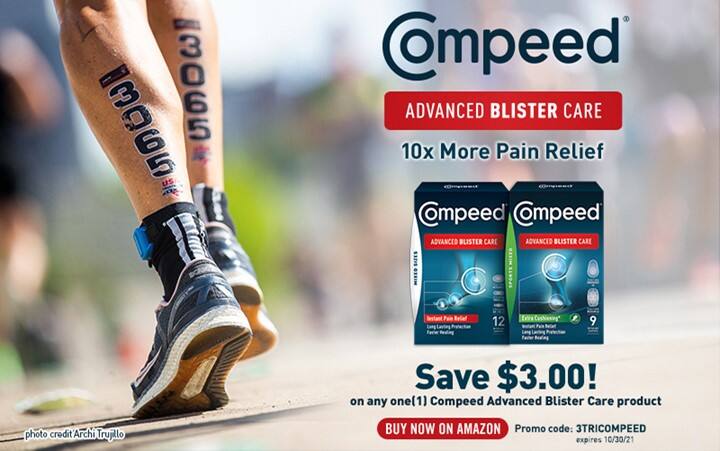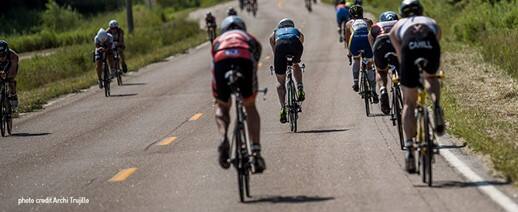
Coach Athletes to Outrun Blisters
by Compeed

Coach Athletes to Outrun Blisters
Just as strength, speed and endurance are important to performance, so is the prevention and treatment of blisters, which have the potential to derail even the most elite athlete.
Coaches Can Help Prevent, Treat Blisters Before They Affect Athletes’ Performance
It’s triathlon season, which means it’s also blister season. And while blisters might seem trivial, maybe even a rite of passage -- who doesn’t have a great story about finishing a race with an oozing heel -- they can affect performance as much as a shin splint or broken bone.
Triathletes in particular are susceptible to blisters, as these competitors repeat the same motion for miles on end. That means tens of thousands of opportunities for running or biking shoes to rub up against heels or toes, even foot pads. This literal pounding, in conjunction with perspiration from exertion, provides the ideal environment for blisters to form. Diving into cool open water might sound like soothing relief, but there are better ways to deal with a blister.
Coaches can help reduce, if not eliminate, the cycle of elite exercise and blisters in three ways: educating athletes on how these fluid-filled bubbles form; providing tips for prevention and treatment; and having blister bandages such as Compeed Advanced Blister Care on hand.
Birth of a Blister
The most common type of blister for a triathlete is the friction blister. That’s that pesky pocket of fluid that forms in the upper layers of skin after too much stress and friction, typically from shoes. As the top layer of skin is rubbed away from the lower layers, fluid fills the gap, cushioning the tissue from further damage.
Here’s a more detailed explanation (not for the weak of stomach): Called mechanical injuries, blisters occur due to excessive shear force between the surface of the skin and the rest of the body. The layer of skin most susceptible to shear force is the stratum spinosum. As this layer tears away from the tissues below, a plasma-like fluid leaks from the cells and begins to fill the gap that is created between those two layers. This fluid encourages new growth and regeneration. If the top layer (the roof) tears, plasma will leak out of the blister, and eventually the entire roof will come off.

Guide to Prevention
The goal therefore is to prevent blisters. This is actually easier than it sounds. Elite athletes are used to using equipment that keeps them safe while competing. That means running shoes, for example, that fit well -- not too snug -- and provide the cushioning and support appropriate for the way an individual runs. As for socks? Forget what you were told as a child. Cotton socks might “breathe,” but the material actually keeps moisture on the skin. This increases the friction -- and boom, blister time. A better option: moisture-wicking socks, typically made of synthetic fabrics (and worth the investment!). Some athletes even change their socks during competition to keep their feet dry and minimize the opportunity for moisture to get trapped on their skin.
Foot powder can help by absorbing moisture, but it also can clump and create friction. So this requires trial and error to determine the right amount for each person.
Be Prepared
One trick is to keep blister cushions on hand during training and competition. When an athlete feels the telltale signs – tender, hot, maybe itching skin -- apply a specialist blister bandage such as Compeed, which is waterproof and sweatproof. This could out and out prevent a blister from forming, or at least stop one from worsening.
Compeed Advanced Blister Care uses hydrocolloid gel to absorb moisture and help the healing (20% faster than an ordinary bandage). The Compeed pad itself is extra-cushioned to protect tender skin and prevent additional friction from damaging it. An ordinary bandage is likely to scrunch up and eventually fall off, often taking skin with it and creating even more discomfort or pain. Compeed, on the other hand, securely adheres to healthy skin and won’t come off until it’s ready to come off -- typically in a few days.
If, despite their best efforts, an athlete still gets a blister, proper treatment and protection is the key to a quick recovery.
Clean the area immediately if possible. The best course of action is to keep the blister from tearing, so the skin underneath can heal on its own. Therefore, eliminating or reducing the source of friction is necessary. A Compeed Advanced Blister Care bandage will help by providing deep cushioning, reducing pressure and creating a moist environment, thus optimizing the time for the blister to heal under this protective second skin.
Just Say No
Coaches should discourage athletes from popping their blisters. Blister fluid encourages new growth and regeneration of the underlying skin. The best way for a blister to heal fast is to keep it intact under a protective moist environment like a Compeed cushion. That said, it could pop on its own if left unprotected. In either case, use an antiseptic to clean the area or rinse it with salt water or clean running water, dry well and then cover with a clean blister bandage. A hydrocolloid pad such as Compeed is particularly well-suited for this situation because it will provide excellent cushioning, thus alleviating pain in this highly sensitive area and promoting faster healing.
People often make the mistake of removing a blister bandage at night so the wound can “air.” Again, remind athletes that blisters actually heal faster in a moist healing environment. So, wear a protective bandage like Compeed. When the bandage starts to peel away, this is an indication the blister is healing. And of course if there are any signs of infection -- pain, swelling, redness, warmth, red streaks leading away from the blister or pus coming from it -- see a doctor.
Interested in offering Compeed® Advanced Blister Care samples at your next race?
■ 1 COUNT INDIVIDUALLY WRAPPED SAMPLES ARE FREE
■ INCLUDES INFORMATIONAL LEAFLET & COUPON
■ PERFECT AS A GIVEAWAY FOR ATHLETES & SPECTATORS
For more information on samples or full-sized products, email Caryn at
c.friedman-ext@HRA-PHARMA.COM at least 20 days prior to your event.
For sample requests, please include:
■ Race date(s)
■ Shipping address
■ Number of samples needed
■ Expected number of participants & spectators
FULL-SIZED PRODUCTS CAN BE PURCHASED AT A SPECIAL RATE!